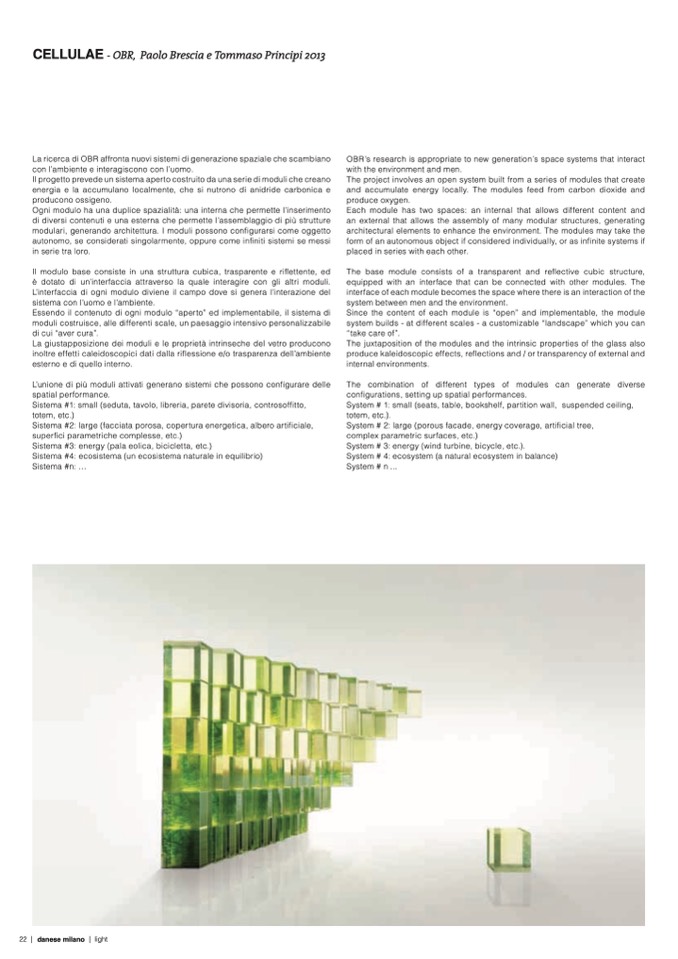
CELLULAE - OBR, Paolo Brescia e Tommaso Principi 2013
La ricerca di OBR affronta nuovi sistemi di generazione spaziale che scambiano
con l’ambiente e interagiscono con l’uomo.
Il progetto prevede un sistema aperto costruito da una serie di moduli che creano
energia e la accumulano localmente, che si nutrono di anidride carbonica e
producono ossigeno.
Ogni modulo ha una duplice spazialità: una interna che permette l’inserimento
di diversi contenuti e una esterna che permette l’assemblaggio di più strutture
modulari, generando architettura. I moduli possono configurarsi come oggetto
autonomo, se considerati singolarmente, oppure come infiniti sistemi se messi
in serie tra loro.
Il modulo base consiste in una struttura cubica, trasparente e riflettente, ed
è dotato di un’interfaccia attraverso la quale interagire con gli altri moduli.
L’interfaccia di ogni modulo diviene il campo dove si genera l’interazione del
sistema con l’uomo e l’ambiente.
Essendo il contenuto di ogni modulo “aperto” ed implementabile, il sistema di
moduli costruisce, alle differenti scale, un paesaggio intensivo personalizzabile
di cui “aver cura”.
La giustapposizione dei moduli e le proprietà intrinseche del vetro producono
inoltre effetti caleidoscopici dati dalla riflessione e/o trasparenza dell’ambiente
esterno e di quello interno.
L’unione di più moduli attivati generano sistemi che possono configurare delle
spatial performance.
Sistema #1: small (seduta, tavolo, libreria, parete divisoria, controsoffitto,
totem, etc.)
Sistema #2: large (facciata porosa, copertura energetica, albero artificiale,
superfici parametriche complesse, etc.)
Sistema #3: energy (pala eolica, bicicletta, etc.)
Sistema #4: ecosistema (un ecosistema naturale in equilibrio)
Sistema #n: ...
OBR’s research is appropriate to new generation ́s space systems that interact
with the environment and men.
The project involves an open system built from a series of modules that create
and accumulate energy locally. The modules feed from carbon dioxide and
produce oxygen.
Each module has two spaces: an internal that allows different content and
an external that allows the assembly of many modular structures, generating
architectural elements to enhance the environment. The modules may take the
form of an autonomous object if considered individually, or as infinite systems if
placed in series with each other.
The base module consists of a transparent and reflective cubic structure,
equipped with an interface that can be connected with other modules. The
interface of each module becomes the space where there is an interaction of the
system between men and the environment.
Since the content of each module is “open” and implementable, the module
system builds - at different scales - a customizable “landscape” which you can
“take care of”.
The juxtaposition of the modules and the intrinsic properties of the glass also
produce kaleidoscopic effects, reflections and / or transparency of external and
internal environments.
The combination of different types of modules can generate diverse
configurations, setting up spatial performances.
System # 1: small (seats, table, bookshelf, partition wall, suspended ceiling,
totem, etc.).
System # 2: large (porous facade, energy coverage, artificial tree,
complex parametric surfaces, etc.)
System # 3: energy (wind turbine, bicycle, etc.).
System # 4: ecosystem (a natural ecosystem in balance)
System # n ...
22 |
danese milano | light

